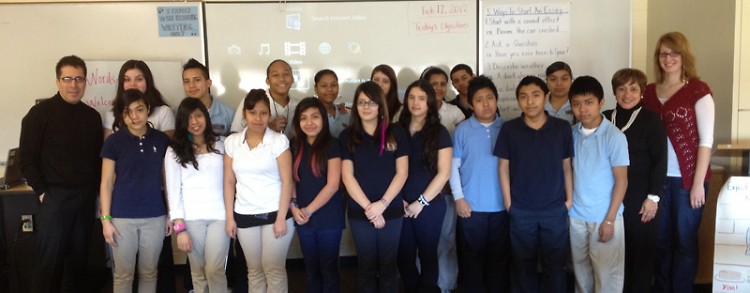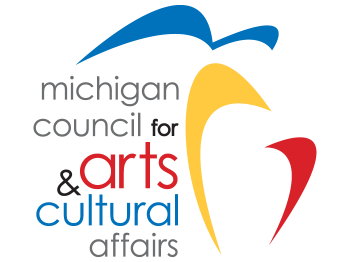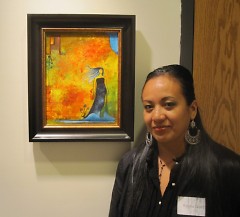Leer este artículo en español | Read this article in Spanish
“Will this project help my brother come back to us after being deported?” This question was asked by an 8th grade student [whose identity has been removed to protect her family] at Southwest Community Campus (SWCC). Her class had just been introduced to their assignment for the semester. The students were told to write an article about immigration or injustice, and then create a piece of artwork to pair with the article. They would then publish the article with the artwork and share the story. Questions like hers are what inspired the idea for the assignment in the first place, but it’s much more than just a school assignment. Alejandro Escamilla’s “Words R Us” project is a collaboration of journalism and art, designed to help give his students an outlet and a voice.
Escamilla teaches journalism to 7th and 8th graders at SWCC. Through various conversations and assignments in class, he discovered that many of his students were being directly affected by immigration policies and issues. Over time it became increasingly clear that many of them felt helpless and voiceless on the subject. Inspired to give them courage and hope, he formed the idea for “Words R Us,” envisioning an exhibition of student articles and artwork on the subject of immigration. He hoped it would be the perfect opportunity for his class to express themselves in a positive, productive manner. Escamilla did not only hope to provide an outlet for his students, he also wanted to provide awareness in the community about what these kids are going through.
To make the project a reality, Escamilla teamed up with Grandville Avenue Arts & Humanities and The Rapidian to apply for an Arts Education Grant from the Arts Council of Greater Grand Rapids. The grant was awarded and Escamilla’s students got started.
The students are hard at work on their articles and in March, Escamilla’s class will be travelling to the Cook Arts Center once a week to work directly with Reyna Garcia, a local artist whose work focuses on the subject. She’ll be discussing symbolism and identity and working with them to create mixed-media collages while sharing her own experiences on creating artwork on the subject of immigration. "Art is essential in our lives," she says. "It's the best heritage for our kids [and] it's a way to assure an excellent future for them." The faceless figures and shifting light sources in Garcia’s paintings allude to feelings of identity loss and confusion – feelings that many of Escamilla’s students are all too familiar with.
The intense emotional connection that students have with the subject matter is somewhat alarming. When the project was introduced it prompted a barrage of questions. One boy asked if people would actually read their articles while another student questioned whether or not they could even make a difference here in the Grand Rapids community. Someone brought up the letdown of the Dream Act not passing and asked, “If we write about the Dream Act can we actually make a difference?” This seemed to stir up even more questions. “If we graduate from high school, will we even able to go college? What if we’re not even here anymore?” Another girl waited until after class to ask, “Is there hope for me to go to college even though the Dream Act was a failure?”
According to Marjorie Kuipers, GAAH’s Executive Director, the answer to her question is, “Yes, that’s why we’re here.” She reflects on the mission of the organization and talks about how this project truly embodies it. “We’re here to provide these students with life-changing opportunities. Yes, our programs are fun and they keep kids off the streets after school, but that’s just scraping the surface of what we’re doing here,” Kuipers says. “Encouraging our neighborhood residents to read and write and express themselves through the arts is what we do. We don’t exist to get involved in politics or stand behind issues for groups of people; we exist to give people the tools to pursue those dreams themselves.”
The Rapidian shared the sentiment. Chelsea LaForge, The Rapidian’s Community Engagement Specialist, said, “The Rapidian works really hard to promote the voices of everyone within our community. [We provide] a lot of tools for people to pursue their passions. Simply existing and allowing anyone to be a reporter means that we’re providing a way for writers to explore their skills and maybe develop new ones. We also work with more than just words, and provide tools for photography, videography, and any other form of storytelling that our community wants to learn about… we’re willing to take the necessary steps to ensure the citizens of Grand Rapids have a platform to share their stories and learn something along the way.”
LaForge is also working directly with the students on the project. After visiting the classroom and introducing the website, her enthusiasm was palpable. “I suppose I’m most excited about this project because these kids might not even know this is a passion of theirs yet. I get to be involved in a group of students exploring the tools we offer and watch them experience a new kind of media maybe for the first time. Even if out of all of those students, one light bulb goes off and they find joy and purpose with this project, then I will be ecstatic.”
Students were asked about some of their hopes and fears related to the project. Noemi G., age 13, knew immediately what she hoped to accomplish. “I just want people to understand, or at least try to. I want people to listen instead of just hearing. When you hear something you think about it for a while but then forget. When you really listen to something deeply, that’s when you begin to understand.” She also admitted that she’s afraid of making things worse. “I’m scared to draw more attention to all the immigration issues and make something drastic happen on accident. [I might make] some type of mistake and make everything worse.”
Omar G., also 13, said that he’s not afraid; he just has hopes to remind fellow citizens that “…everybody is a person – it doesn’t matter how they look or what they do [for a living]. People have the right to go to college and get their papers to stay here.”
After student articles and artwork are completed The Rapidian will be publishing their work under the GAAH News Bureau. The Rapidian audience is being asked to click the "Vote Up" button on the article that they are most drawn to, impressed by, or like the most. Feel free to vote for more than one. The student(s) with the most votes at the end with receive special recognition at the exhibition of their work, scheduled for May and open to the public.
The Rapidian, a program of the 501(c)3 nonprofit Community Media Center, relies on the community’s support to help cover the cost of training reporters and publishing content.
We need your help.
If each of our readers and content creators who values this community platform help support its creation and maintenance, The Rapidian can continue to educate and facilitate a conversation around issues for years to come.
Please support The Rapidian and make a contribution today.


